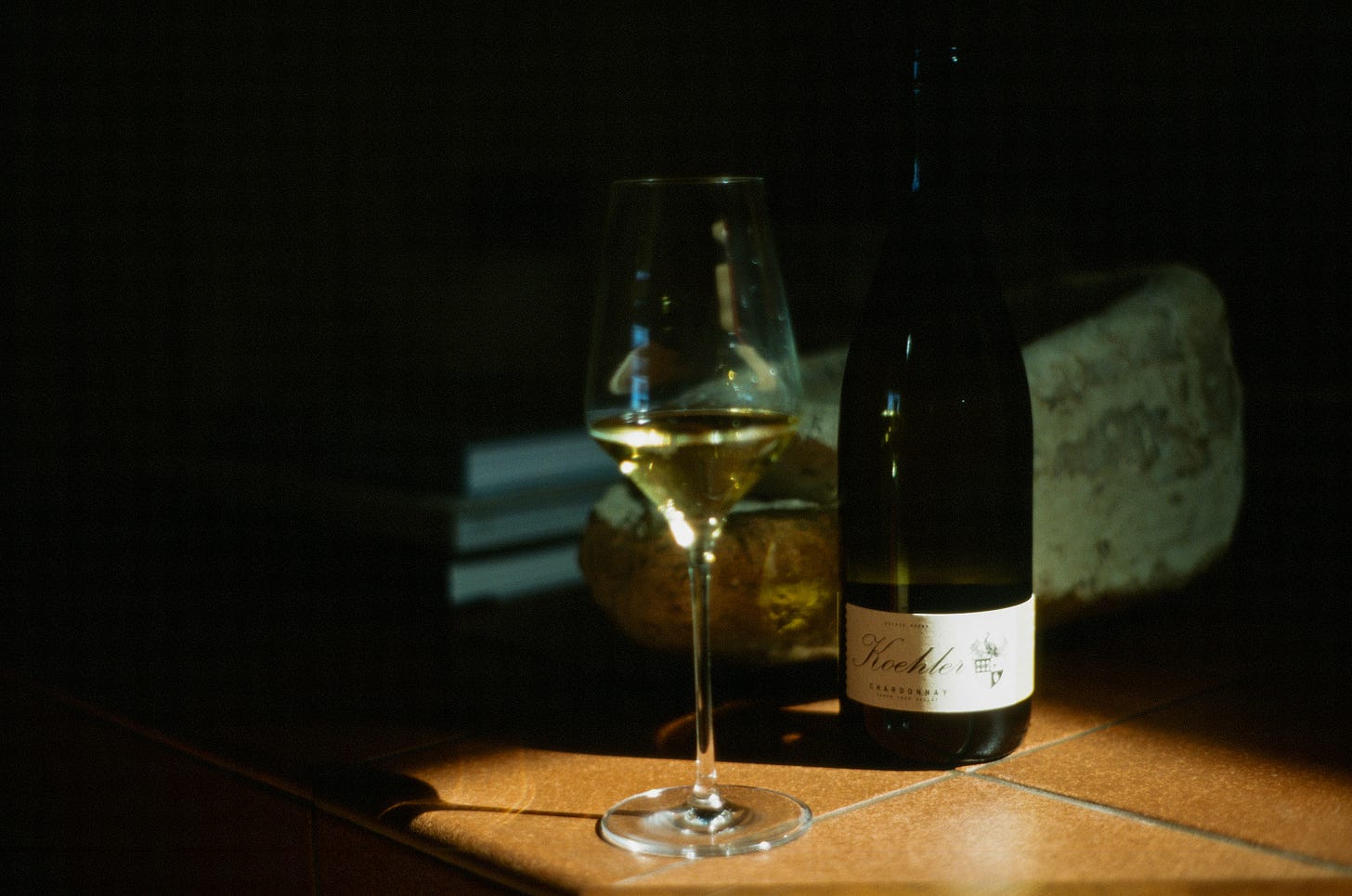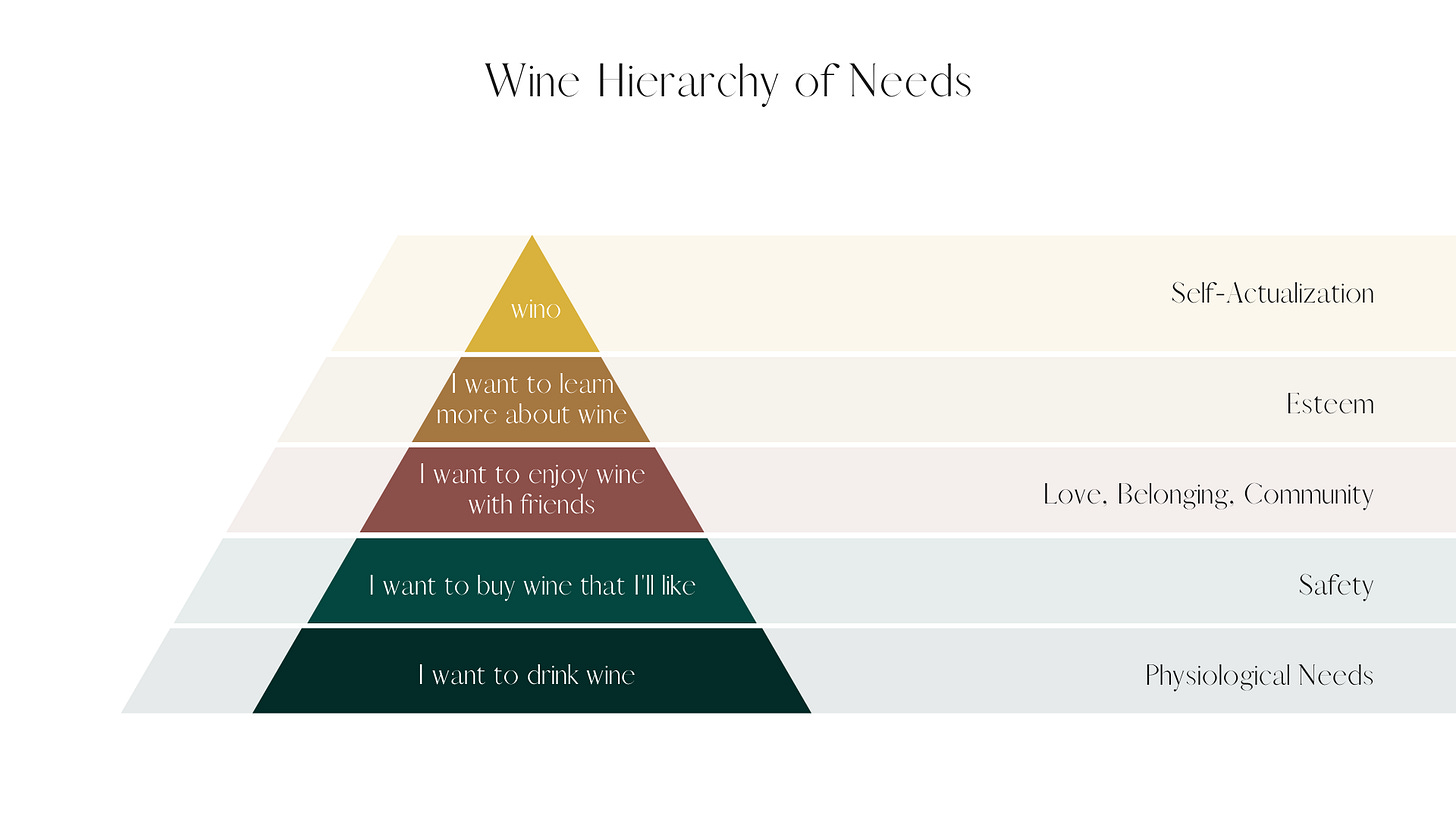Not Everyone Wants to Be a Wine Geek
Understanding where your customer is on their wine journey.
A few months ago, on Pour Memories (the conversational podcast I cohost), my friend Kristin and I were laughing about the fact that most wine drinkers, even (and probably especially) us industry folk, have, at some point, enjoyed wine out of a tumbler, a mason jar, or even a coffee mug. I talked a bit about this in my post Why Isn’t Wine a Moving Day Beverage? as well. And yet, a lot of wineries market to their customers as if they are further along in their wine journey than they are.
Many don’t even have a real understanding of where their customers even are in their wine journey. So, today I think it’d be wise for us to go back to the beginning and get to know our customers a little better, understanding what they need.
The Wino’s Hierarchy of Needs
The easiest way to look at this is through a concept that Amber LeBeau of Spit Bucket Blog fame first adapted from Maslow’s Hierarchy of Needs in her article “Stop Scaring the Newbies — A Look at the Wine Hierarchy of Needs” It’s a brilliant way to visualize the stages wine drinkers go through and a bit of a cheat sheet, if you will, for tailoring your marketing to where your customers are at.
Here is how Amber has laid out the different stages of a wine drinker’s journey,
Level 1: Pleasure – “I drink wine with my food or because I enjoy it.”
Level 2: Safety – “I want to know I’ll like it before I buy it.”
Level 3: Belonging – “I want to go tasting, join wine clubs, attend events.”
Level 4: Esteem – “I want to learn more, try new varietals, and share my discoveries.”
Level 5: Self-Actualization – “I’m a wine professional/collector. This is my identity.”
Also, I think it’s important to highlight a key point Amber makes in this article: Not everyone wants to “move up” the pyramid, and that’s totally fine! That said, there are ways we can encourage them to get curious about wine rather than scaring them into retreating.
The Marketing Gap
Most wineries jump straight to marketing for Level 4 and 5, the wine geeks, the collectors, and the industry insiders.
But not all wineries actually want to sell only to those people. Many want to reach newbies or social drinkers primarily, but don’t know how. So they copy what they see from wineries whose audiences are the geeks and collectors.
The result is marketing that talks past their actual customers, and sometimes actively scares them away.
Knowing your ideal customer’s level of understanding of wine is just as important as knowing their demographics. Marketing to Millennials is going to look different than marketing to Boomers, right? Likewise, marketing to a Millennial who’s a serious collector will be very different from marketing to a Millennial who’s just getting curious about wine, and marketing to a Boomer who exclusively likes semi-sparkling, semi-sweet muscat (hi, mom) is different from marketing to a Boomer with a 500-bottle cellar.
A lot of wineries make blanket assumptions. They assume all Gen Z customers are beginners in the world of wine (many are, but not all), and they assume all Boomers are seasoned collectors (again, not true). My own mom, for example, is very happy at Level 1, drinking what I jokingly refer to as “Cougar Juice” (the aforementioned semi-sweet, semi-sparkling muscat), whereas my dad likes exploring different wines and learning about how a wine is made and why.
If you skip figuring out where your audience is on their wine journey and focus only on age, you risk missing the mark with both your messaging and your offers.
How to Market to Each Level
Here’s how to think about content for each stage of the wine journey:
Level 1: I want to drink wine (Pleasure)
At this stage, wine is a beverage they enjoy, a means to an end if you will. Maybe they have it with dinner, maybe at a party, maybe only on special occasions. Your goal here is to show how your wine fits into their everyday life without overcomplicating it. But also, please don’t infantilize it. We are trying to help them move up the pyramid, after all, and no one likes to be talked down to.
Post ideas:
Food pairing reels or a carousel of three takeout pairings. “Our rosé pairs perfectly with burgers and fries.”
Mood-focused content can help them picture themselves enjoying your wine in a specific, relatable setting. “A glass of Pinot Noir, your favorite playlist, and a quiet night in.”
Encourage them to swap a less awesome wine for something better. “Your Wednesday night pasta deserves better than whatever’s been open in the fridge for a week.”
Make it relatable and easy to imagine, but don’t dumb it down; you’re giving them ways to see themselves drinking your wine, not talking to them like they’ve never even heard of wine before.
Level 2: I want to buy wine I’ll like (Safety)
Here, drinkers are trying to avoid “wasting” money on something they won’t enjoy. They tend to always reach for the same variety, style, or even winery because it’s safe and they know they will like it. Your goal is to build trust with them and give them language to describe their preferences, without shaming them for what they like.
Post ideas:
“If you like X, try Y” recommendations. “If you like Pinot Noir for its fruitiness and low tannins, you might love Gamay because of these reasons.”
Friendly style explainers. “Not all riesling is sweet! If you’ve been avoiding riesling because of this common misconception, here’s why you might like our dry riesling.”
Guides to your most approachable bottles. Something like “The three most popular wines in our tasting room (and why people love them)” offers them social proof.
Level 3: I want to enjoy wine with friends (Belonging)
We have precedent that wine is a social beverage. Customers at this stage want experiences and community! Your goal with these folks is to show them they’re welcome and that wine is better when shared.
Post ideas:
Curated wine lists for gatherings: Make it easy for them to know what to bring when they’re hosting or attending a social event. “3 wines for your next BBQ.”
Staff spotlights to build familiarity: Introduce your team so your customers feel like they’re visiting friends, not strangers, when they come by the tasting room.
Club member perks and event invites: Show them what being part of your winery’s community looks like, and make it feel irresistible.
P.S. Be sure to show photos of diverse groups enjoying your tasting room. Make it intersectional, a.f. Representation matters. Also, be sure to highlight your key demographics. If you want to reach Gen Z, maybe don’t exclusively show a bunch of photos of old white men and women at your tasting room, just a thought.
Level 4: I really want to learn more (Esteem)
These customers are curious. They often enjoy feeling knowledgeable and getting to share the stories or information about the wines when they bring a bottle to share with friends. Your goal with these nerds is to feed their curiosity and give them the language they need for those encounters.
Post ideas:
Behind-the-scenes harvest videos are great for sharing the work that goes into making your customer’s new favorite wine.
Step-by-step looks at bottling or blending: “Ever wondered how a blend comes together? Here’s how we go from tasting individual barrels to (making awesome wine)”
Educational features on grape varieties or vineyard practices: “What makes Albariño so crisp and refreshing? We’ll tell ya!”
Level 5: I’m a wino (Self-Actualization)
Wine is a part of their identity, and they’re ready for special bottles and rare experiences! Your goal with the winos is to offer them exclusivity and insider access, and make them feel extra special.
Post ideas:
Library release announcements: Give them first dibs on rare and back-vintage wines. “We aged it for you” is a good message with these folks who can sometimes be paralyzed when pulling from their own collection.
Invitations to intimate winemaker dinners: Create experiences where they can deepen their connection to the people and stories behind the wine. “Join our winemaker for a five-course pairing dinner in the barrel room! Only 20 seats available.”
Early access to limited allocations: Reward their loyalty with access that others don’t get.
The Champagne Point — Wine as Everyday Joy
Even if your ideal customer lives at the top of the pyramid, it’s worth remembering that wine can (and should) still bring joy in simple, everyday moments. Because while the winos at the tippy top of the pyramid might chase rare vintages, they also appreciate the casual magic of opening something great “just because.”
Marketing wine only as a “special occasion” product reinforces intimidation and slows customer growth.
As Kristin says in the podcast, she’s been known to open champagne “just to feel pretty,” which is the cutest thing I’ve ever heard in my life. I believe that regardless of the level our customers are at in their wine journey, we should encourage that kind of enjoyment of wine. I hate to say we need to “give them permission” because that implies that there is still some kind of gatekeeping going on, but we do need to normalize it.
The more we show wine as a natural, joyful part of everyday life, not just something reserved for special occasions, the more we chip away at the bullshit intimidation that’s run rampant in the wine industry for decades. When customers see themselves reflected in that everyday joy, they’re more likely to buy, open, and share your wine without waiting for an “official” reason.
Reaching Multiple Levels Without Confusing Your Audience
It’s absolutely okay if you want to reach customers at more than one level of the Wino’s Hierarchy of Needs. A lot of wineries do because one’s customer base probably isn’t made up of just newbies or only collectors.
But you need to be crystal clear about who you’re talking to in each specific post. A post meant for Level 1 drinkers should be instantly accessible and relatable, not bogged down with technical vineyard notes. A post meant for Level 4–5 drinkers should satisfy their curiosity and expertise without spending three paragraphs defining terroir.
Your Next Steps
Define Your Target Audience: Take fifteen minutes to think about the person you are trying to reach. How old are they? What is their gender identity? How much money do they make? Do they have a dog? Kids? What are their hobbies and interests? And most relevant to this conversation, where are they in their wine journey?
Create parallel messages for your current core customer and another to attract the next stage up the pyramid.
Test one wine by marketing it specifically for Level 1–2 drinkers and see what happens.
Listen to the Episode
If you want to hear Kristin and me spiral into tangents about Pedro Pascal and how not to scare off new wine drinkers, listen to the full Pour Memories episode here.





I love this so much! The model of the Wino's Hierarchy of Needs and the post ideas for each level are fantastic. Thank you for such an informative and helpful post!
P.S. I absolutely agree that wine should be a moving day beverage!
As someone who spent a decent number of years mucking about at level 5, and eventually realized level 1 was more enjoyable, I think the pyramid might be inverted.... 🤔